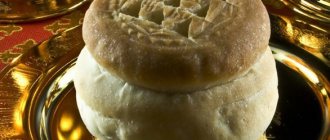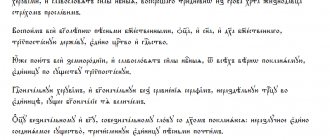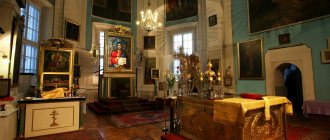Bread has been used in worship since Old Testament times.
Bread is an ancient food. For many peoples, it symbolizes well-being and life. satiety. It is not surprising that even in Old Testament times, priests used bread in worship. In the book of Leviticus we read:
“He shall bring leavened bread as his offering, with a peace offering of thanksgiving.”
(Lev. 7:13)
But still, this is sacrificial bread, and the topic of the article is holy bread. Christianity uses bread in various types of worship. The significance of this particular product is significant, for Jesus Christ himself paid attention to it in the New Testament:
“And he took the bread and gave thanks, broke it and gave it to them, saying: This is My body, which is given for you; do this in remembrance of Me.”
(Luke 22:19)
Ritual
For a very long time there has been a tradition of sewing small bags with drawstrings in order to carry and store prosphora. If you have one, then there is no need for any bags, and you will no longer be afraid that the blessed bread may be dropped or forgotten somewhere. And in the moment of some kind of trouble, you can take out the artos with peace of mind. These bags are called prosphora bags or prosphora bags; they are often very beautifully decorated with rhinestones or beads, various embroideries and ribbons. You can sew them yourself or buy them in church shops.
Many parishioners who have recently come to thoughts about God and decided to devote their lives to prayers for their family and friends do not know the rules and wonder what kind of bread this is - artos, and how to take it correctly. Now let's try to understand this matter a little.
Any bread in Orthodox worship is prosphora
Prosphora (prosvira) is liturgical bread. It has been used since the first centuries.
There were no established liturgical traditions and no church property. The believers themselves brought everything they needed.
That’s where the name comes from – translated from Greek as “donation”.
Prosphora - consecrated liturgical bread
Initially, prosvira was the name for everything that was required for the liturgy, but then this word became established only in relation to bread.
At first, by the way, he was very ordinary. Only later did church recipes appear, and donations gradually became monetary rather than property.
5 particles
removed from prosphora in Orthodox worship
The prosphora is not used in its entirety in Orthodox worship. Using a copy, particles are removed from it. Traditionally, there are five prosphoras, of which, accordingly, the middle is taken:
- lamb;
- in memory of the Mother of God;
- in memory of the saints;
- in memory of the living;
- in memory of the dead.
The lamb is cut out of the prosphora with a copy.
After the liturgy, believers can eat the used prosphora and take the leftovers home. They are given out behind a candle box.
Recipe
Take 1 kg 200 g of flour, preferably premium quality. Pour a little holy water into the bottom of the bowl where the dough will be kneaded. Pour in 400 g of flour and pour over very hot water. This is done to impart sweetness and resistance to mildew. Mix everything and cool. Then add salt, having previously diluted it in holy water, and add 25 g of yeast. Mix everything well and wait 30 minutes. Next, add flour (800 g) and mix again. As soon as the dough has risen, place it on the table and roll it out with a rolling pin into sheets of the required thickness.
Cut into circles; for the lowest part of the artos, make a larger circle. Then cover with a damp towel, and then with a dry one, and wait another 30 minutes. A stamp is placed on the top. Then both parts need to be lubricated with warm water and connected. Pierce both parts to prevent voids from forming. Then place on a baking sheet and bake in the oven until done. Small ones are baked for 15 minutes, service ones - about 20 minutes.
Artos is a particularly revered Easter prosphora
Technically, this is also prosphora , holy bread. Although it is larger in size than the usual church bread for the liturgy. At the top of the artos they depict the Life-Giving Cross or the Resurrection of the Lord. Another name for artos is whole prosphora.
Artos is illuminated on Easter day and placed on a lectern. There the bread is kept until Bright Saturday of Bright Week, and during Bright Week a procession of the cross is made with artos around the temple. The implication is that the bread is an image of Christ.
Artos recalls the Resurrection of the Savior and the victory over death.
This is not just bread that is given in church, but a Christian symbol. Tradition says that the apostles always perceived Jesus Christ as their companion. When they sat down to eat, they left bread to treat their crucified Teacher.
The tradition went beyond the circle of the apostle, spread to temple services, and now artos is a symbol dating back to distant New Testament times, to the disciples of Christ.
Looking at the artos, the believer remembers the Resurrection of the Savior, his appearances to the apostles, and victory over death.
Artos - a large prosphora for the Easter service
The priest reads a prayer over the artos:
“Almighty God, Lord Almighty! You commanded through Your servant Moses, during the exodus of Israel from Egypt and the liberation of Your people from bitter slavery, that Pharaoh should slaughter the lamb,
prefiguring the Lamb voluntarily slain for us on the Cross,
Who takes away the sins of the whole world, Your beloved Son,
Our Lord Jesus Christ,
through whom we received liberation and escape from eternal slavery to the enemy and deliverance from the indestructible bonds of hell. So do we
Thy servants, in honor and glory, and in remembrance of the glorious resurrection of Thy Son,
Our Lord Jesus Christ, now on this all-blessed day,
and glorious and saving day of Easter, offering this bread before Your Majesty,
We humbly pray to You: look at this bread, bless and sanctify it.
We, who brought it and kissed it,
and make those who partake of it partakers of Your heavenly blessing and remove from us all sickness and disease by Your power,
giving health to everyone. For You are the source of blessings and healings, the Giver,
and we send up glory to You, the Beginning Father, with Your Only Begotten Son,
and Your Most Holy and Good Life-Giving Spirit, now and always, and unto the ages of ages.”
Then the bread is sprinkled with holy water three times with the words:
“This artos is blessed and sanctified by sprinkling this holy water, in the name of the Father, and the Son, and the Holy Spirit. Amen".
At the end, the artos is crushed and distributed among the believers. This bread is sacred, and therefore not everyone considers it wise to take it and eat it right away. Artos is recommended to eat in case of severe ailments.
Innocent of Kherson said this about this:
“It should be used with reverence as a shrine, but no greater significance should be attached to it.
Some people think that this bread can replace the divine Communion of the Holy Mysteries of Christ.
This opinion is sinful; a Christian must know and remember that nothing, no shrine can replace the Most Pure Body and Blood of our Lord Jesus Christ.
Therefore, there is no need to store this bread for a whole year, as some do, attributing to artos a meaning that it does not have.
This is also prohibited by the church authorities (Decree of the Holy Synod of 1723, June 15).”
Innocent of Kherson
bishop
But if you want to preserve artos for a long time, it is better to make crackers out of it, otherwise the bread will become moldy.
Prayer for the acceptance of artos is not provided for by church canons, but two options can be used:
- say “Christ is Risen!”;
- change the text of the prayer for the acceptance of holy gifts and holy water:
“Lord my God, may artos be for the enlightenment of my mind, for the strengthening of my mental and physical strength, for the health of my soul and body,
to conquer my passions and infirmities by
to Thy boundless mercy through the prayers of Thy Most Pure Mother and all Thy Saints. Amen".
Artos is higher in grace than prosphora, but lower than antidor.
Belief
An ancient church tradition is also associated with this product. It lies in the fact that the apostles at the table left a small part of the bread - this was the share of the Mother of God. In this way they reminded themselves of constant communication with her and after eating, they shared this part among themselves with all trepidation. In all monasteries this tradition is called the “Rite of Panagia”, which means remembrance of the Mother of God. In parish churches this is done once a year; the custom is associated with the crushing of the artos.
It is consecrated with a special prayer, sprinkled with holy water, and on the first day of Easter they go to all liturgies, as soon as the prayer behind the pulpit, which is read by the priest himself, ends. It is so called because to pronounce it, the reader descends from a raised platform in front of the altar, the outermost projection of which is called the pulpit. But usually the priest, in order to read the prayer behind the pulpit, does not descend, but stands on it, because from this elevation everything is perfectly audible to those present in the church.
Easter bread artos is placed on the salt (this is such a raised platform in front of the iconostasis in the Orthodox Church, as if a continuation of the altar), opposite the royal doors, on a specially prepared table. And a special prayer is read for the sacrament of its fragmentation. During this ritual, there is a deacon (this is a church minister who helps the priest conduct the rituals, but does not have the right to perform them independently), parishioners and, of course, the priest. The prayer he reads talks about the miracle created by Christ, when he fed the needy people with five loaves of bread, despite all their illnesses and sins. People ask the Holy Trinity for the sacred artos to give health to the body and internal state. They praise God and thank him for his endless kindness and love for people.
After the bread is blessed, it, together with the stand on which it lies, is placed on a raised platform in front of the image of the Savior himself. The bread is there throughout Holy Week.
Artos is taken on all days of this holiday. We’ll find out how to use it correctly a little later. When the liturgy with the sacred Easter cake ends, a religious procession is held around the temple in a solemn atmosphere. On Saturday, after the prayer behind the pulpit, another prayer is read - for grinding the artos. It is broken up at the very end of the liturgy, when the cross is kissed, after which it is distributed to everyone present as a shrine, then a prayer is read for the acceptance of the artos. It says that bread and water, prepared in a special way in church with certain prayers and mood, can strengthen a person’s health and fortitude. He believes that he can become a better person with the help of God, who treats people mercifully, as the saints and the Mother of God pray for all humanity.
Those small particles (antidor) of the holy bread that were distributed in the church are very carefully kept at home in a corner next to the icons.
The highest church bread by grace is called antidor, these are fragments of lamb prosphora
These are parts of the prosphora from which the Lamb is removed. It is considered the most sacred and gracious of the rest, and therefore antidor in Orthodoxy is the most holy of all types of bread.
It is customary to eat it immediately and on an empty stomach, unless, of course, the state on an empty stomach is not harmful to health.
Antidor - particles of prosphora after the removal of the Lamb
Believers take the antidor with their palms folded crosswise - right to left. Then you are supposed to kiss the hand of the priest who served the antidor.
It happens that believers do not have enough antidor from lamb prosphora. Then the antidor is made from prosphora in memory of the Virgin Mary.
Prosphora, its meaning and history of appearance
Prosphora is an integral part of the Liturgy; it is also called liturgical bread. The sacrament of the Eucharist, the commemoration of the deceased at Proskomedia, occurs during the reception of holy bread by Christians - a piece of prosphora.
The first mention of church bread prepared for sacrifice is in the Old Testament (Leviticus 7:13), when God ordered leavened baked goods to be prepared for sacrifice. In the tabernacle, during the campaign of Moses and the Jewish people through the desert, also by command of the Creator, there was always the bread of show, but unleavened. It had two parts - symbols of earthly human life and heavenly Divine life. The showbread is a type of Jesus, who became the Bread of Life, being God and man.
Prosphora breads are baked by specially trained people, prosphora bakers, and at large churches there are prosphora bakeries where holy bread is baked. The recipe for church baked goods is based on holy water, wheat flour, leaven and salt. Hops, raisins or ordinary yeast are used as starter culture.
Holy water is a symbol of grace, leaven is the life-giving power of the Holy Spirit.
Important! A distinctive feature of the prosphora from other bread products in the church is the symbolic abbreviation placed in the middle of the upper part. Prosphora
To apply an image signifying that Christ is victorious, special forms are used. The holy loaf consists of two parts, as in Old Testament times, symbolizing Jesus both man and God.
Five prosphoras are prepared for Proskomedia, each of which has its own purpose. From one, as a prototype of the Lamb, pieces are taken out for the communion of believers; the other pays tribute to the memory of the Mother of God, saints and deceased people.
After the end of the Liturgy, believers eat prosphora with reverent prayer and reverence, communing with the body of Christ, accepting His sacrifice for the life of all believers. The remaining pieces of prosphora - antidor - are distributed to parishioners to take after morning prayers.
How to store a shrine
Like any shrine, artos requires a reverent attitude - if neglected, it, like ordinary bread, can become moldy. For long-term storage, it is usually divided into small pieces and, after drying, stored in a bag (preferably linen).
Believers believe that eating holy bread helps with various diseases and grants healing and good health. The old Russian custom has been preserved: when it was not possible to get to the Holy Week service, the shrine was consumed on an empty stomach with holy water. The shrine is used in special cases, for example in illness, and always with the words “Christ is risen!”
The artos is kept in a secluded place, most often near icons or any other things memorable to a Christian. Church bread is usually placed in small linen bags, but the bag can be replaced with a regular bag.






